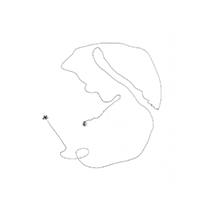November 26, 2022
Spirit Spirit - Torben Snekkestad / Søren Kjærgaard / Tomo Jacobson
 Label: Gotta Let it Out Records: website & Bandcamp
Label: Gotta Let it Out Records: website & Bandcamp
Catalog #: GLIO53LP
Location: Copenhagen, Denmark
Release Date: December 31, 2021
Media: lp or digital download
bandcamp.com entry
discogs.com entry
The staff of the Poison Pie Publishing House were drawn to this album by the three individuals in the ensemble. Over the past five years, we have really enjoyed a number of amazing, ear-opening records from the Gotta Let it Out label, several of which feature Tomo Jacobson on double bass (see the links to related reviews below) and some of which that do not (e.g. Høbama). Jacobson's esthetics expressed through his instrument appeal to us. We have a lesser familiarity with the saxophonist on this record, Torben Snekkestad. As best as memory serves, we have only heard his playing on one record, Inferences (Fundacja Słuchaj!, 2019), a trio with Evan Parker and Lotte Anker, but we loved that album so much we put it on our 2019 Top Ten Records list. We were long overdue to hear another recording including Snekkestad. As for the pianist Søren Kjærgaard, we don't think that we had ever heard any music by him before Spirit Spirit. Of course, this is our favorite kind of improvised music, where familiar musicians introduce us to voices new to our ears.
The ten tracks on Spirit Spirit cover a range of territory. Some of the music is sparse to the point where minimalism and deconstruction are terms that come to mind. There are musicians who make deconstruction of a music or of an instrument the central theme of their investigation. Keith Rowe on guitar, Sachiko M (the self-dubbed Queen of the Sine Wave) on electronics or Birgit Ulher & Leonel Kaplan on Stereo Trumpet (Relative Pitch, 2015) all come to mind. In such endeavors, melody is a foreign commodity. In constrast, there exist many other efforts to deconstruct jazz into its primordial elements, distilling the music into phrases in which melody and rhythm, while diluted or decoupled, are not entirely abandoned. Two recent jazz records that call to mind this approach are Canto (ILK Music, 2022) by Emanuele Maniscalco, Francesco Bigoni & Mark Solborg and Uneasy (ECM Records, 2021) by Vijay Iyer, Linda May Han Oh & Tyshawn Sorey. If we create a spectrum with deconstructive minimalism at one end and jazz decomposition at the other, we find that Snekkestad, Kjærgaard & Jacobson have placed Spirit Spirit somewhere between the two extremes. The trio draws from both conceptual sources, presenting the instruments as sound-generating objects while encouraging the possibility for the three objects to collaboratively produce tunes that we are not averse to describing as jazz.
The trio generated three hours of improvised music in the studio. From this material, roughly thirty-eight minutes have been selected for Spirit Spirit. What the listener has then are pieces of an incomplete puzzle. The significant gaps between the selections available must be filled by the listener's imagination. This calls to mind a favorite quote from the British guitarist, Derek Bailey (1930-2005).
In so far as I listen with interest to a record, it's usually to figure out how it was arrived at.
The musical end product is where interest starts to flag. It's a bit like jigsaw puzzles.
Emptied out of the box, there's a heap of pieces, all shapes, sizes and colours, in themselves attractive and could add up to anything—intriguing.
Figuring out how to put them together can be interesting, but what you finish up with as often as not is a picture of unsurpassed banality.
Music's like that.
—Derek Bailey, from Derek Bailey and the Story of Free Improvisation by Ben Watson, Verso, London, 2004, p. 440.
While Bailey's self-deprecating sense of humor and his refusal to place his own music on a pedestal are well-documented, Spirit Spirit does allow Snekkestad, Kjærgaard & Jacobson to prompt the listener to wonder about the process by which this music came together. By withholding the majority of the pieces, they prevent the music from succumbing to the threat of banality. Upon first listening, this music for saxophone, piano and bass immediately signalled that a single listening would be insufficient to fully digest it. Having listened to it repeatedly over the course of a month, we are no closer now to solving the riddle but we are happy to admit to having passed the time in an amiable way.

personnel:

